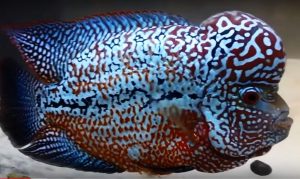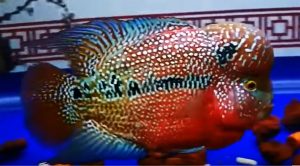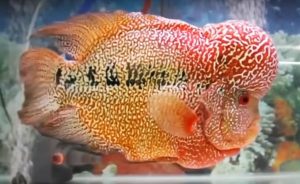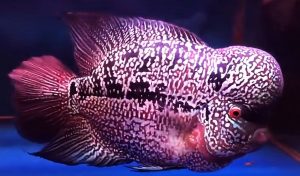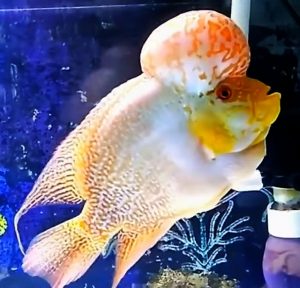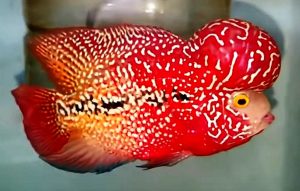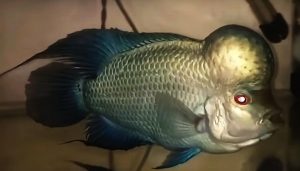The Flowerhorn Cichlid (Cichlasoma X) known to tropical fish keeping enthusiasts simply as Flowerhorns, was first developed in Malaysia, Taiwan, and Thailand and except for culled specimens that were intentionally dumped into the ponds and riverine ecosystems of Malaysia and Singapore, does not occur naturally in the wild.
The Flowerhorn Cichlid Hybrid originated in Asia and is believed to have been initially bred in 1993 and 1994 in western Taiwan and Malaysia by crossing Amphilophus labiatus (Red Devil Cichlid) and Amphilophus trimaculatus (Trimac cichlid) that were imported from Central America to Malaysia, with the hybrid Blood Parrot Cichlid that had been imported from Taiwan to Malaysia.
The Flowerhorns slightly protruding head with long tail fins were prized by the Taiwanese for bringing good luck, and in 1995, Blood Parrot Cichlids were further crossbred with Flowerhorns to produce new color strains.
Because of their beautiful colors, protruding nuchal humps, long fins, and friendly personalities towards humans, Flowerhorn Chchlid Hybrids quickly became popular with tropical fish keeping enthusiasts worldwide.
Selective crossbreeding of the species continued through 1998 with the Seven Color Blue Fiery Mouth (Greenish Gold Tiger) imported from Central America and the Jin Gang Blood Parrot from Taiwan to produce the first generation of hua luo han flowerhorn hybrids generically referred to in English as luohans. These were then followed by subsequent flowerhorn introductions.
A large number of Flowerhorn Cichlid Hybrid cast offs were released into the wild, primarily in Singapore and Malaysia. These flourished to the extent that they are now considered an invasive pest species in that area of the world.
When louhans were first imported into the United States, only two varieties of Flowerhorns (those with white spots, called pearls, and those without) and two varieties of Golden Base (faded and non faded) were available to tropical fish keeping enthusiasts.
The flowerhorn hybrids with white spots immediately became very popular and were called Pearl Scale Flowerhorns, which were later developed into the Zhen Zhu variety.
The faded gray skin Golden Bases also gained in popularity when they developed into an attractive golden skin variety.
Commercial breeders continued crossbreeding fertile Flowerhorns until in 1999, four varieties became available to tropical fish keeping enthusiasts:
- Regular Flowerhorns
- Pearl Scale Flowerhorns
- Golden Flowerhorns
- Faders
The Kamfa variety of Flowerhorns had some new traits like short mouths, wrapped tails, sunken eyes, and larger head bumps. This cross between any species of the genus Vieja or Parrot Cichlid, with any kind of Flowerhorn appeared around 2001.
Competitive breeding of Flowerhorns continues to this day with more colorful strains being developed every few years. Currently, there are five distinct variations of Flowerhorn Chiclids:
- Golden Base
- Golden Monkey
- Kamfa
- Thai Silk
- Zhen Zhou
The Flowerhorn Cichlid Hybrid is hard not to notice. They are vividly colored and have thick oval shaped bodies, distinctively shaped heads with a large nauchal hump, long pointed trailing dorsal and anal fins, a spade shaped caudal fin, and like other cichlids, along with their regular teeth, a set of well developed pharyngeal teeth in their throat.
Almost all varieties of Flowerhorn Chchlid Hybrids have black
horizontal markings on their flanks. Their scales are multicolored with hues that vary from metallic green with pinks and reds on the front half of the body, to metallic blue.
An interesting characteristic of Flowerhorns is that the colors and patterns of these fish will constantly change until they become fully mature adults.
Male Flowerhorn Cichlid Hybrids are generally larger than females, are more vividly colored, have a larger nuchal hump, longer dorsal and anal fins, and develop a thicker more pronounced mouth than females.
Females are generally smaller than males, have black dots on their dorsal fins, and tend to have more orange bellies, especially during breeding. Adult females will also lay eggs every month even without the presence of a male in the tank.
All Flowerhorn Cichlid Hybrids are highly aggressive and are best kept in a single species tank. Although pairs can be kept very large aquariums, some type of glass or acrylic divider is highly recommended to separate them until they show signs of compatibility.
Because many long bodied varieties of Flowerhorn Cichlid Hybrids grow to almost 16 inches in length, single specimens are best housed in an aquarium of at least 100 gallon capacity with a sand, tile, or large gravel substrate, some rocks fashioned into hiding places, a few pieces of driftwood or bogwood, and some hardy plants like Anubias
, etc. for aesthetics.
Flowerhorns are large, strong fish that produce a lot of waste and require a good filtration system with moderate to high water flow in their tanks. They prefer soft to moderately hard water and are extremely sensitive to ammonia, nitrates, and nitrites in the aquarium.
A wet/dry trickle filter, large Bio-wheel, or canister filtration system along with a powerhead
mounted close to the bottom of the tank and regular bi-weekly water changes is recommended to keep them healthy and happy.
Although Flowerhorn Cichlid Hybrids are able to tolerate a variety of water conditions, stability is more important than maintaining perfect water quality.
Because the majority of male Flowerhorn Cichlid Hybrids are sterile and cannot reproduce, most tropical fish keeping enthusiasts find that Flowerhorns are extremely difficult to breed.
Breeders must wait for males to reach sexual maturity before attempting to pair them up with females and test their fertility. This can take as long as 8-12 months.
In addition, their fiercely territorial aggressiveness towards other members of their species often results in severe injuries or death to their mates.
Breeders start by placing an upside down ceramic flowerpot into the breeding tank to give the potential pair a place to spawn. If the tank has a fine gravel or sandy substrate, the male will scoop out a depression or hole in the substrate for the female Flowerhorn to deposit her eggs.
If the reproductive period has not yet begun, the male and female Flowerhorns kept in the same tank may attack and/or kill each other. However, if the stars align, the male will clean an area of the flowerpot or fan out a depression in the substrate for the female to deposit her eggs and the pair will spawn.
When ready to mate, the male will try to attract the female to the cleaned area for spawning by displaying, touching, and finally embracing her. When ready to mate, the female will nestle into the male and the eggs will be deposited and immediately fertilized by the male.
If the fish attack each other after spawning, remove the male and leave the female in the tank to oversee incubation of the eggs or, remove both parents and incubate the eggs artificially. When doing this, add a few drops of methylene blue to the water to prevent fungal infections from killing the eggs.
When free swimming, the fry will accept finely ground flake foods, newly hatched brine shrimp, etc.
Flowerhorn Cichlid Hybrids are not picky eaters and will accept almost anything placed into the tank. They require a protein rich diet and should be provided a staple carnivore pellet along with live, frozen, or freeze dried crickets, grasshoppers, shrimp, mealworms, white worms, black worms, earthworms, nightcrawlers, etc. Feed a varied diet with several small meals a day in lieu of a single large meal.
Flowerhorn Cichlid Hybrids of all types are available from specialty fish shops and online from a variety of websites and demand a hefty price depending on size and the hybrid type purchased.
Minimum Tank Size: 100 gallons
Care Level: Difficult
Temperament: Extremely Aggressive
Aquarium Hardiness: Hardy
Water Conditions: 80-85°F, dH 6-20°d, pH 6.0-8.0
Max. Size: 12-16″
Color Form: Red, Yellow, Green
Diet: Carnivore
Compatibility: Single species
Origin: Variable Southeast Asia
Family: Cichlidae
Lifespan: Short Body 4-5 years
Long Body 8-12 years
Aquarist Experience Level: Intermediate


